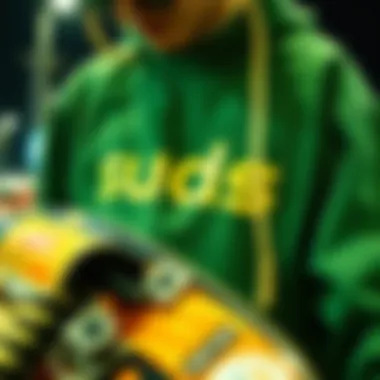Urban Wear Brands: Fashion Meets Skate Culture


Intro
Urban wear is more than just a style; it's a cultural phenomenon that intertwines the raw essence of skateboarding with fashion. Over the years, urban wear has evolved from its street origins, influenced by various subcultures and social movements. By examining urban wear brands, we not only get a glimpse of the latest trends but also understand how these brands reflect community identities and values. This article sets out to explore the shifting landscape of urban wear, particularly its symbiotic relationship with skate culture, while highlighting key brands that have left an indelible mark on this vibrant scene.
Skills Development
Basic Tricks and Techniques
For skaters, mastering the basics is crucial before diving into the more complex maneuvers. Tricks like the ollie, kickflip, and grind are foundational skills that every skater must learn. These techniques not only enhance one’s ability on the board but also contribute to one’s style, an important aspect of urban wear.
- Ollie: This is the bread and butter of skateboarding. It involves popping the tail of the skateboard while jumping, allowing the board to rise. The ollie serves as the gateway to various tricks that follow.
- Kickflip: After successfully landing an ollie, the kickflip adds flair. The skater flicks their foot out to the side, causing the board to flip in mid-air.
- Grinds: Finding the right edge or rail to grind is part of the urban skater’s adventure. A grind involves sliding along an edge with the trucks of the skateboard, showcasing both balance and style.
Practicing these basic tricks not only builds confidence but also lays the groundwork for advanced techniques. Skaters can practice these skills in local parks or streets, allowing them to embrace their urban environment fully.
Advanced Maneuvers and Tips
As skaters gain confidence, the next step is to tackle more advanced tricks. Here, creativity meets skill, as individuals can blend their personalities through their skateboarding style.
- Heelflip: Similar to the kickflip, but with a flick of the heel. It requires precision and can impress audiences when executed smoothly.
- 360 Flip: Combining a kickflip and a 360 spin, this trick is quite a crowd-pleaser. It requires practice and timing to pull off successfully.
- Backside Smith Grind: An advanced grind mounted on the edge with the back truck. This maneuver emphasizes control and flair, particularly in competition settings.
Experimentation is vital; encourage skaters to try new tricks but also to stay true to their unique style. One way to learn is through community events or contests, where seasoned skaters offer valuable insights.
Gear and Equipment Reviews
Skateboards and Accessories
Selecting the right gear is essential to improving performance and ensuring safety. Here are some standout products worth considering:
- Element Skateboards: Known for their durability and style, Element skateboards provide excellent boards for beginners and advanced skaters alike.
- Bones Bearings: They are the gold standard for skateboard bearings, ensuring smooth rides and long-lasting performance.
- Anti-Hero Skateboards: A popular choice, particularly among street skaters, for those who want something edgy yet reliable.
Safety Gear and Recommendations
Safety should never take a back seat. Here are essential pieces of gear that every skater should own:
- Helmet: A sturdy helmet is non-negotiable. Look for brands like Bell or Pro-Tec, which combine comfort and protection.
- Knee and Elbow Pads: Protecting these areas can prevent serious injuries. The Triple Eight brand offers reliable options for all levels of skaters.
- Skate Shoes: Invest in shoes that offer grip and flexibility. Brands like Vans or Adidas make excellent skate-specific footwear designed for performance.
Wearing protective gear not only safeguards skaters but also allows for a confidence boost while learning new tricks. Engaging in communities, whether online or at local skate parks, can provide insights into personal gear preferences and recommendations.
Culmination
As we traverse the world of urban wear and its significant ties to skateboarding, it becomes evident that this intersection is not just about clothing or tricks. It's about a lifestyle, a way for communities to express their essence. Urban wear brands have pioneered this ethos, delivering fashion that mirrors the grit and grace of the skateboarding culture. Through understanding this landscape, readers can appreciate the cultural significance behind each stitch and skate trick.
Preamble to Urban Wear
In the ever-evolving canvas of fashion, urban wear stands as a vibrant and essential expression of culture, a testament to the rich tapestry of influences that merge music, art, and lifestyle. This section introduces urban wear as not just clothing, but as a cultural phenomenon that reflects and shapes identities, particularly for the youth and those immersed in skate culture. The nuances of urban wear encompass far more than aesthetics; they speak to resilience, community, and individual narratives engraved in the fabric of each piece.
Urban wear encapsulates a dynamic blend of styles, originating from the streets and resonating with the ideals of freedom and self-expression. The garments represent more than a fashion choice; they sit at the intersection of personal identity and community engagement. Reflecting both local and global trends, urban clothing channels the energy of bustling cities and the grit of skate parks, fostering connections among varied audiences. As skaters don their gear, they aren't simply choosing comfort; they are wearing a badge of their community, ideals, and lifestyle.
Understanding urban wear involves delving into its intricate roots and the historical context behind its emergence. The evolution of this fashion genre offers insights into societal shifts, highlighting the importance of grassroots movements and cultural revolutions. For many, urban wear is also intertwined with skateboarding—a sport that has consistently influenced fashion trends since the late 20th century, forging a space where style and functionality coexist.
Through this article, we shall explore the many facets of urban wear: its definition, historical influences, key brands contributing to its evolution, and the market dynamics shaping its future. By unpacking these layers, we aim to provide readers with a comprehensive understanding of what urban wear signifies today.
Roots of Urban Wear in Skate Culture
The world of urban wear is deeply intertwined with the pulse of skate culture. Understanding this relationship goes beyond mere fashion; it reveals how communities express themselves through style, values, and shared experiences. Urban wear is not just clothing—it’s a portrayal of identity, capturing a lifestyle that resonates with skaters and fashion enthusiasts alike. The roots of urban wear can be traced back to skater sensibilities which emphasize individuality and rebellion. As important as comfy shoes and durable clothing are for a skateboarder, these choices carry a weight of cultural significance that is hard to miss.


The Evolution from Streetwear
Streetwear began as a form of self-expression, born out of urban environments where skateboarding thrived. In its early days, this style was heavily influenced by graffiti, hip-hop, and a certain edge that resonated with youth culture. The graphic tees, oversized hoodies, and sporty silhouettes that make up streetwear reflect a lifestyle that's dynamic and uncontainable. One could say it fosters a “wear what ya want” attitude—the very essence of freedom.
Over the years, streetwear has morphed into a significant force in fashion, impacting not only what we see on the streets but in high-fashion runways as well. What initially started as simply wearing comfortable clothes for skating has evolved into a full-blown industry where brands collaborate with artists and influencers, bridging the gap between fashion and accessibility. This evolution hasn’t just changed what people wear; it has challenged traditional fashion ideals, opening doors for self-expression and activism through clothing.
Influence of Skateboarding
Iconic Styles
Iconic styles in skate culture are a hallmark of individuality and attitude. Think of the relaxed fit jeans paired with classic graphic tees or the layered looks that often include a flannel or bomber jacket. Skaters are not just about comfort; they’re also about standing out. These styles often reflect the personality of the rider, with brands like Vans and Thrasher becoming synonymous with the sport itself. Their designs, which often feature bold prints and recognizable logos, allow skaters to proudly display their passion for the craft.
One might argue that the laid-back vibe of these styles makes them an appealing choice for many. It’s comfortable, practical, and yet, carries an air of effortless cool. The uniqueness of this iconic style is in its ability to blend function with flair—allowing skaters to express who they are while performing at their best. However, as popular as these styles may be, they can occasionally fall into the realm of imitation, reducing some of the original uniqueness.
Prominent Skate Brands
Prominent skate brands play a critical role in shaping the culture, influencing not just style, but the very ethos of urban wear. Companies like Santa Cruz, Element, and Plan B have not only pushed quality skateboards but have also created clothing that reflects the skate lifestyle. Their involvement in skate competitions and sponsorship of athletes adds layers to their credibility.
The key characteristic of these brands is their genuine connection to the skate scene. They’re not just selling clothes; they’re cultivating a community and ensuring that their designs speak to the core values of skating—authenticity and perseverance. A unique feature of these brands is the collaboration with various artists or influencers, which often leads to limited-edition drops that are highly coveted among fans.
However, as the market grows, so does the risk of mainstream appeal which can dilute the original spirit of skating. It raises the question: Are brands staying true to their roots or simply chasing trends? While these prominent skate brands continue to offer quality and style, the challenge lies in balancing commercial success with the cultures they represent.
"Urban wear and skate culture are not just trends; they’re movements that reflect the lives and stories of those who wear them."
By diving deeper into the roots of urban wear in skate culture, we can appreciate the layers of identity and expression within these styles. The fusion of functionality and aesthetic in skate fashion creates a powerful conversation about community, individuality, and representation. As we explore more about key urban wear brands next, it’s important to keep in mind how these elements have shaped today’s cultural landscape.
Key Urban Wear Brands
Urban wear brands play a pivotal role within the landscape of fashion, particularly at the crossroads of street style and skate culture. They represent more than just clothing; these brands encapsulate identities, attitudes, and a certain lifestyle that resonates with skaters and urban dwellers alike. Their designs, often infused with rebellion and creativity, articulate community values and reflect social realities of the streets. Given the unique position urban wear holds in this nexus, it is essential to understand the contributions of significant brands that have made a lasting impact on this culture.
Supreme: The Trendsetter
Supreme is not just a brand; it’s a cultural phenomenon. Established in 1994 in New York City, this label tapped into the burgeoning skate culture, quickly catapulting to fame with its iconic box logo. It serves as a touchstone for the urban wear community, known for its strategic collaborations with high-profile brands and artists. The exclusivity it offers through limited releases drives demand and creates a sense of urgency—one moment you’re looking at a T-shirt, and the next, it’s a treasured collectible.
- Signifying Status: Supreme has skillfully turned its brand into a status symbol in both skate and mainstream culture, with items often reselling for astronomical prices.
- Collaborative Spirit: The brand's partnerships with names like Nike and The North Face illustrate its influence, showcasing its ability to merge streetwear with haute couture. This amalgamation alters perceptions, blurring the lines between high fashion and everyday wear.
Stüssy: Origins and Impact
Stüssy originated during the 1980s in California, blending surfing, skate, and hip-hop cultures. It was one of the first brands to give streetwear a distinct identity. The casual yet edgy aesthetic draws in consumers longing for authenticity and a connection to the original skate community.
- Cultural Mixture: Its designs often feature graphics inspired by surf culture, which uniquely positions Stüssy at the intersection of multiple subcultures.
- Visual Language: The logo itself, a stylized signature of its founder, Shawn Stüssy, has become synonymous with urban wear. It's not merely a brand identifier; it's a cultural icon that represents the spirit of free movement and street authenticity.
Palace Skateboards: The UK Representation
Palace Skateboards extends urban wear's influence beyond the Atlantic, embodying the gritty realism of London while embracing a playful, irreverent approach. Founded by Lev Tanju in 2009, Palace has become a definitive voice in British skate culture, resonating deeply not just in the UK, but around the globe.
- British Aesthetic: Known for its bold graphics and unique cuts, Palace emphasizes individuality, catering to a younger crowd that seeks innovative designs over mainstream aesthetics.
- Community Engagement: The brand's savvy marketing tactics—like tongue-in-cheek social media campaigns—create engagement and community, reminding consumers of the cultural significance behind what they wear.
Vans: More Than Just Shoes
Vans, perhaps best known for its iconic slip-on shoes, has been associated with skate culture since the 1970s. The brand's accessibility and reliable performance have made it a staple for skateboarders around the world.
- Cultural Embedment: Vans' deep roots in skateboarding are evident in its partnerships with pro skaters and sponsorships of skate events, establishing a genuine bond with the skate community.
- Versatile Style: Its commitment to offering both classic and new styles ensures that Vans remains relevant, appealing to a broad spectrum of urban wear enthusiasts. It's a brand that evolves while staying true to its original ethos.
"Vans has stood the test of time due to its balance of style and functionality—qualities that are essential for any skater."


In summary, these key urban wear brands not only shape the fashion landscape but also influence cultural dialogue within skate culture. Their unique attributes and relationships with their communities enable them to thrive, underscoring the importance of authenticity and purpose in fashion today. Understanding these brands gives us a clearer view of the intersection between streetwear and skateboarding, enriching our appreciation for the vibrant tapestry of urban fashion.
Market Dynamics of Urban Wear
Understanding the market dynamics of urban wear is essential for analyzing how this fashion niche thrives within the larger landscape of street culture and consumer habits. Urban wear operates at the crossroads of style, identity, and cultural commentary, making it a significant player in today’s fashion ecosystem. The intersection between fashion and skate culture reveals not just trends but also the undercurrents that drive consumer choices.
The significance lies in how urban wear brands manage to adapt to shifting consumer demands while remaining authentic to their roots. This segment is not merely about selling clothes; it’s about crafting a lifestyle and narrative that resonates with distinct communities. By dissecting these dynamics, we’ll uncover the motives that fuel purchasing decisions and the broader implications of those choices in the society.
Consumer Behavior
Consumer behavior in the realm of urban wear is influenced by a myriad of factors. Skate culture, for example, promotes individuality and self-expression, and these attributes flow directly into the shopping habits of its followers.
Some important aspects to consider regarding consumer behavior include:
- Brand Loyalty: Buyers often form strong attachments to brands that reflect their values and beliefs. Take Stüssy, for instance, which has built a loyal following by consistently promoting authenticity in its designs.
- Social Influence: The power of social media cannot be overstated. Marketing strategies often leverage platforms like Instagram and TikTok to create buzz around new collections, heavily impacting purchase decisions among younger demographics.
- Peer Validation: In skate culture, what your friends wear can significantly influence your own choices. There’s a sense of belonging formed through fashion that ties consumers to the broader community.
Additionally, the new wave of conscious consumerism is leading more buyers to consider the ethics behind their apparel choices. Sustainable practices and eco-friendly materials are beginning to weigh heavily on purchase decisions.
Trends Shaping the Market
Numerous trends are currently shaping the urban wear market, each reflecting shifts in societal attitudes and technological advancements. Understanding these trends helps to predict future directions and shifts within urban fashion.
A few noteworthy trends include:
- Sustainability: Eco-conscious brands are on the rise, as customers are becoming increasingly aware of environmental impacts. Brands like Patagonia set an example with their commitment to ethical manufacturing processes.
- Limited Editions and Collaborations: High-profile partnerships between brands lead to exclusive collections that generate hype. For example, the collaboration between Adidas and Pharrell Williams resulted in buzzworthy, limited-edition items that flew off the shelves.
- Digital Influence: The rise of augmented reality (AR) and virtual reality (VR) is changing how urban wear is marketed. Online fit checks and virtual try-ons can enhance customer engagement, bridging the gap between digital and physical shopping experiences.
"Fashion is the armor to survive the reality of everyday life." - Bill Cunningham
For more in-depth discussions about trends in urban wear, resources such as Wikipedia, Britannica, and community insights on platforms like Reddit can provide a broader context.
Collaboration and Limited Editions
Collaboration and limited editions have become pivotal in the landscape of urban wear, acting as a bridge between fashion trends and skate culture. This phenomenon has reshaped consumer expectations and defined exclusivity in ways that traditional retail simply cannot match. The appeal of limited drops generates a sense of urgency, compelling fans and collectors alike to get their hands on these coveted pieces.
In the context of urban wear brands, the cozy relationships established through collaborations often lead to innovative designs and fresh aesthetics that reflect the melting pot of street culture. As brands partner with artists, musicians, or even other fashion labels, the resulting products blend distinctive elements from various realms. In turn, this collaboration fosters a sense of community and shared identity among skaters and fashion enthusiasts.
Brand Partnerships
Brand partnerships often seem like a match made in streetwear heaven. One of the most striking illustrations is the collaboration between Nike and Supreme. Their joint venture produced the iconic Supreme Air Force 1. Not only did this sneaker merge the sporty elegance of Nike with the edgy vibes of Supreme, but it also set the stage for future teamwork across various labels. Such partnerships open doors for experimentation that can push creative boundaries, breathing new life into established brands while maintaining their core philosophies.
Other noteworthy collaborations include Adidas with Pusha T and BAPE, where luxury meets street sensibility. These collaborations often speak to the fans’ desire for authenticity and originality, as they can wear pieces that are steeped in meaning and connected to their favorite culture figures.
Moreover, the interchange of ideas through partnerships allows urban brands to tap into new markets, reaching consumers who may not have previously considered their products. They become more than just clothing; they offer a glimpse into a lifestyle that resonates with authenticity and community.
Impact on Collectibility
The world of urban wear is also intertwined with the concept of collectibility, largely thanks to collaborations and limited editions. When a drop is announced, oftentimes it creates a frenzy, leading to long lines outside of stores or websites crashing under user demand. Skaters and fashion aficionados recognize that limited-edition items hold intrinsic value, which can increase over time.
“Limited drops boost the thrill of ownership; they’re not just clothes but tokens of culture.”
Collectibility propels urban wear into the realm of investment. For instance, a pair of Travis Scott designed Air Jordans can quickly become a prized possession, fetching a price far beyond its original retail value in the resale market. The implications are profound; fashion is no longer simply about style, but has evolved into a currency within the culture.
Culmination
Ultimately, collaboration and limited editions enable both established and emerging brands to leave a lasting imprint on the urban wear scene. They redefine the relationship between brands and their communities, by not merely selling clothes but fostering identity and cultural significance. By navigating this unique confluence of creativity and commerce, urban wear brands not only cater to current trends but also lay down the groundwork for future innovations.


For more insight into this subject, you might find this article on Wikipedia useful. Also, for a broader understanding of brand collaborations, consider checking out resources like Britannica for historical context.
Cultural Significance of Urban Wear
Urban wear represents more than just a fashion statement; it embodies cultural expressions, values, and identities tied to the urban experience. As society evolves, so does the role of urban wear, becoming a canvas for discussions around race, class, and social issues. This dynamic category of clothing captures the essence of a generation, resonating deeply with its community.
Urban Wear as Identity
For many, urban wear gives a sense of belonging. It reflects the realities of life in the city—its vibrance, diversity, and sometimes the struggles one faces. This connection goes beyond fabric and stitching, intertwining fashion with identity.
Take, for example, how wearers often leverage their clothing and style choices to project individuality. The oversized fits popularized by brands like A Bathing Ape or Fear of God are not merely about comfort; they signal a rejection of the conventional norms aligned with mainstream fashion. These choices are often about claiming a space, a culture that celebrates uniqueness and creativity, and that’s what makes urban wear so impactful.
Moreover, urban wear can function as a powerful social tool. The statement t-shirts, graphic designs, and bold logos serve as mediums for self-expression and assertion of cultural pride. For instance, many designs incorporate elements of street art, which is intrinsically tied to urban life, therefore transforming the wearer into a walking testimonial of their environment.
Fashion and Social Commentary
Urban wear transcends mere aesthetics, often sparking conversations about pressing social issues. Consider brands that produce clothing with messages highlighting systemic injustices or those that pay homage to cultural milestones. Off-White, for instance, has used its platform to address topics ranging from racial inequality to urban disenfranchisement.
These garments don’t just look good; they communicate. Wearing such pieces can evoke dialogue among friends, families, and strangers alike, challenging onlookers to reflect on deeper societal questions.
"Fashion is not just something you put on; it’s a statement of who you are and what you stand for."
Brands recognize the power of their influence and harness it to provoke thought. By blending street culture with political messages, they create a narrative that resonates with a contemporary audience, particularly the youth, who bear witness to the world’s ongoing struggles. In this way, urban fashion serves both as a reflection of the current state of society and a questioning of the status quo, pushing the boundaries of traditional fashion into a realm of social activism.
In summary, urban wear is not just about looking good—it's about understanding the culture it originates from, the stories it tells, and the conversations it ignites.
To further explore the cultural and social dimensions of urban wear, visit resources such as Britannica or Wikipedia for a broader perspective.
The Future of Urban Wear
As the world shifts and evolves, so does urban wear. This dynamic intersection of fashion and skate culture is not static; it embodies the spirit of progress, constantly reflecting changing social values and technological advances. The future of urban wear holds significant implications, particularly in how these influences cater to the aspirations and identities of their wearers.
One major factor driving this future is sustainability. Consumers are increasingly aware of their impact on the environment. The urban wear sector has begun to react to this awareness, moving towards eco-friendly materials and production practices. Brands that prioritize sustainable practices can capture the attention of a conscientious audience. With that in mind, here are some noteworthy points about sustainability trends:
- Organic Materials: The demand for organic cotton and other sustainable fabrics is on the rise. Brands are exploring partnerships with farmers who practice sustainable methods.
- Recycled Fabrics: Using recycled materials such as plastic bottles is becoming common. This not only reduces waste but gives consumers a tangible reason to support these brands.
- Less Waste Through Technology: Tech innovations such as 3D printing allow brands to create products with less waste, as materials can be shaped exactly as needed without excess.
In tandem with sustainability, technology and innovation play a critical role in shaping the future of urban wear. The integration of cutting-edge technology opens doors to exciting possibilities.
Here’s how technology is influencing this sector:
- Smart Fabrics: From moisture-wicking materials to clothing that monitors health metrics, smart fabrics combine functionality with style.
- Advanced Online Retail: The way people shop is changing. Augmented reality (AR) allows customers to try on clothes virtually. This not only enhances their shopping experience but also reduces return rates.
- Customization Options: Personalized designs and limited-edition drops made possible by technology resonate with individuality, which is a cornerstone of urban wear's appeal.
"The urban wear landscape will reflect societal changes, making technology and sustainability not just trends but essential aspects of modern identity."
As the fabric of urban wear continues to evolve, they will likely lead the charge on both fashion innovation and societal responsibility. Wearers will choose brands that align with their values, ensuring that the future is not just about looking good but also doing good.
As we look ahead, urban wear brands must navigate the balance between creativity and responsibility. They need to remain ahead of trends while being mindful of their impact on the community and environment. For skaters, parents, and educators, understanding these shifts provides crucial insight into the broader cultural landscape, influencing both personal and communal identities.
Finale: The Lasting Impact of Urban Wear
As we draw the curtains on this exploration of urban wear, it’s vital to reflect on how deeply intertwined this fashion genre is with broader cultural dynamics. Urban wear isn't merely about clothes; it encapsulates attitudes, identities, and the spirit of communities, particularly those rooted in the skate culture. The legacy of urban wear, influenced by skateboarding, speaks volumes about our changing tastes and social constructs.
Reflections on Cultural Fusion
Urban wear serves as a crossroads where diverse cultural influences converge. It’s like a vibrant tapestry woven from the threads of hip-hop, punk, and even high fashion. Each piece of clothing tells a story, reflecting the stories of the people who wear them. The graffiti tags of an urban landscape, the beats of a street corner cypher, and the tricks executed on a skateboard all come together, creating a rich palette of cultural exchange.
This fusion doesn't just shape style choices; it also facilitates dialogues about social issues, such as equality and representation. Brands that embrace this fusion often gain loyal followings not just for their aesthetics but for their statements. For instance, Supreme's collaborations depict not only innovative designs but also a commentary on consumer culture. Urban wear’s cultural significance can be seen as a reflection of societal values, with designers needing to balance commercial success against maintaining authenticity in their messaging.
Urban Wear's Role in Shape-Shifting Fashion Landscapes
The world of fashion is anything but static; changes happen faster than a flick on a skateboard. Urban wear has played a pivotal role in challenging traditional fashion norms. Whereas high fashion was once viewed as a distant and inaccessible entity, urban brands have democratized style, making it chic to embrace individuality.
- Unconventional Collaborations: Many urban wear brands collaborate with mainstream luxury brands, melding street culture with high-fashion vibes. Think of the partnerships like Kanye West’s Yeezy line with Adidas, which changed the game by merging practical sportswear with avant-garde designs.
- Socially Conscious Designs: More and more brands are leaning towards sustainable labor practices and eco-friendly materials. This shift is critical in shaping a new narrative of responsibility that resonates with younger consumers who are increasingly wary of fast fashion and its implications on the planet.
- Evolving Trends: The rise of social media platforms has allowed urban wear brands to connect directly with their target audience, influencing designs and styles almost in real-time. This has created a feedback loop that encourages brands to adapt and evolve continuously, much like the skateboards they represent.







